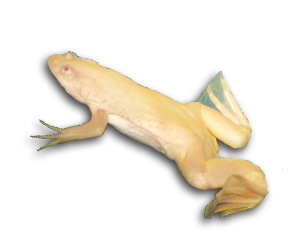African Clawed Frog

Quick Stats
| Size | Up to 6 inches (not including legs) in females. Males smaller. |
|---|---|
| Tank | 60 Litre. (With secure lid). These guys will wander. |
| Swimming Area | Bottom, but will hang out at the surface also. |
| Ph | Not critical |
| Temperature | Very Flexible. Can survive in tropical or cold water tanks. |
| Food | Will thrive on turtle sticks. Will eat fish as it gets older. |
Common Name:
African Clawed Frog
Distribution:
Sub-Saharan African (cooler regions). Introduced/feral in North America and Europe.
Colouration:
African clawed frogs are naturally a mottled green-grey with a lighter, cream-colored underside. The albino version is a pinkish white, and is also readily available from retailers. Males in breeding condition will develop black hands.
Lifespan:
15 Years +
Maintenance:
Weekly water changes with gravel vacuum should be performed without fail. Décor should be upturned and vacuumed under often, as uneaten food may collect under these objects.
Feeding:
The African clawed frog will accept an astonishing variety of foods. They are voracious eaters that will eat almost anything that either smells appetizing, or moves like prey. For this reason, African clawed frogs should NEVER be kept with fish, African dwarf frogs, or other clawed frogs that will fit into their mouths! Even keepers attempting to house them with large goldfish report seeing the frogs latched onto the fish's tail.
Appropriate foods Include:
- Blood Worm (frozen or freeze dried)
- Tubifex Worms
- Mosquito larvae
- Earthworms
- Shrimp pellets (for bottom feeding fish)
- Cooked pieces of shrimp (unseasoned/unsalted)
- Beefheart
- Brine shrimp
- Floating Food Sticks (for turtles)
- Live ghost shrimp
- Live guppies/livebearer fry
Feed 2-3 times a week for adult frogs, more frequently in smaller frogs. You will see your frog "scoop" food towards its mouth with its front feet, because these frogs actually lack tongues with which to grab food.
Important: Never feed rosy red minnows or goldfish to your frog. The majority of African clawed frogs are unable to process an enzyme these fish contain, and can become sick.
Skin Shedding:
African clawed frogs shed their skin every few weeks. They will eat the skin. Excessive skin shedding can indicate pollutants or irritants in the water.
Substrate:
Bare, sand, or very large gravel/small stones. Any gravel/stone used must be too large for them to scoop and/or swallow. Sand is fine enough to pass easily if swallowed.
Tank Decor:
Multiple hiding places (driftwood, caves, etc.) with subdued lighting. Plants should be artificial or very hardy, as these frogs tend to be "big kickers" that rocket around their tanks and tear up live plants.
These frogs are escape artists! The aquarium must be completely covered, or they will find their way onto the floor, where they desicate (dry out) quickly.
If a frog escapes and is found dried up, do not assume it is dead. They have amazing powers of recovery. Place the frog in a shallow bowl of tank water with its nostrils above the water to allow it to breathe. Let the frog rest in the water and watch carefully for movement of the nostrils. It can take several hours for the frog the rehydrate. Once the frogs is able to swim a bit, keep it in a bucket with a few inches of water (or lower the water level of the tank) so it can reach the surface easily for air while it regains strength. Be patient, and do not attempt to feed the frog until it is fully recovered.
Filtration:
Quiet, low-flow filtration is best. These frogs do not appreciate strong current or noisy filtrers.
Biotype:
Stagnant pools and ponds with a deep muddy bottom.
Breeding:
These frogs are easily bred in good conditions. The male will sing to female, and clasp her around the stomach, fertilizing the eggs as she lays them. adults should be removed immediately, as they will eat the eggs/tadpoles. Tadpoles are filter feeders and should be fed finely powdered foods or liquifry.
Other Info:
Baby Clawed Frogs sell in the inch to inch and a half range. At this size they fit well into a community tank of fishes. When they grow to adult size, they will eat any fish they can catch. They can catch them all at night. These frogs should never be kept in an outside pond, as they can survive lower temperatures. They will migrate and will breed readily and therefore will quickly become a threat to local fish stocks. You should never release any pet animal into the wild. Any good petshop should be willing to re-home the animal.